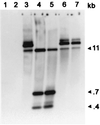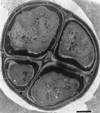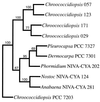Gene transfer to the desiccation-tolerant cyanobacterium Chroococcidiopsis
- PMID: 11244070
- PMCID: PMC95137
- DOI: 10.1128/JB.183.7.2298-2305.2001
Gene transfer to the desiccation-tolerant cyanobacterium Chroococcidiopsis
Abstract
The coccoid cyanobacterium Chroococcidiopsis dominates microbial communities in the most extreme arid hot and cold deserts. These communities withstand constraints that result from multiple cycles of drying and wetting and/or prolonged desiccation, through mechanisms which remain poorly understood. Here we describe the first system for genetic manipulation of Chroococcidiopsis. Plasmids pDUCA7 and pRL489, based on the pDU1 replicon of Nostoc sp. strain PCC 7524, were transferred to different isolates of Chroococcidiopsis via conjugation and electroporation. This report provides the first evidence that pDU1 replicons can be maintained in cyanobacteria other than Nostoc and Anabaena. Following conjugation, both plasmids replicated in Chroococcidiopsis sp. strains 029, 057, and 123 but not in strains 171 and 584. Both plasmids were electroporated into strains 029 and 123 but not into strains 057, 171, and 584. Expression of P(psbA)-luxAB on pRL489 was visualized through in vivo luminescence. Efficiencies of conjugative transfer for pDUCA7 and pRL489 into Chroococcidiopsis sp. strain 029 were approximately 10(-2) and 10(-4) transconjugants per recipient cell, respectively. Conjugative transfer occurred with a lower efficiency into strains 057 and 123. Electrotransformation efficiencies of about 10(-4) electrotransformants per recipient cell were achieved with strains 029 and 123, using either pDUCA7 or pRL489. Extracellular deoxyribonucleases were associated with each of the five strains. Phylogenetic analysis, based upon the V6 to V8 variable regions of 16S rRNA, suggests that desert strains 057, 123, 171, and 029 are distinct from the type species strain Chroococcidiopsis thermalis PCC 7203. The high efficiency of conjugative transfer of Chroococcidiopsis sp. strain 029, from the Negev Desert, Israel, makes this a suitable experimental strain for genetic studies on desiccation tolerance.
Figures




References
-
- Billi D, Potts M. Life without water: responses of prokaryotes to desiccation. In: Storey K B, Storey J M, editors. Environmental stressors and gene responses. Amsterdam, The Netherlands: Elsevier; 2000. pp. 181–192.
-
- Cohen M F, Meeks J C, Cai Y A, Wolk C P. Transposon mutagenesis of heterocyst-forming filamentous cyanobacteria. Methods Enzymol. 1998;297:3–17.
Publication types
MeSH terms
Substances
Associated data
- Actions
- Actions
- Actions
- Actions
LinkOut - more resources
Full Text Sources
Other Literature Sources

